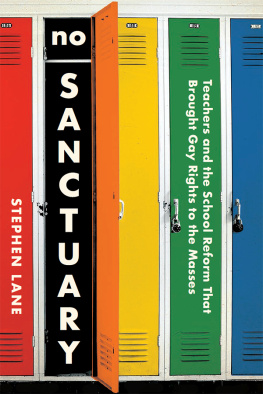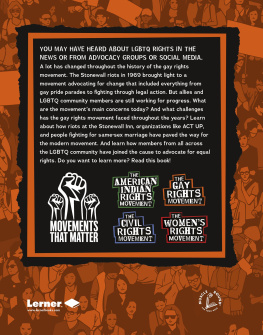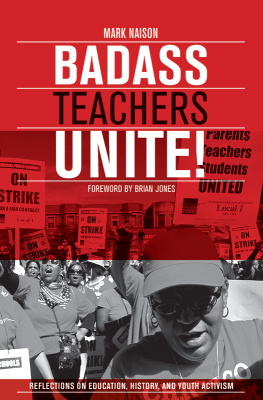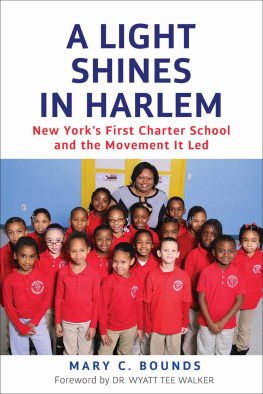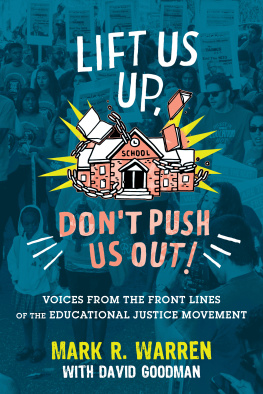
Acronyms and Abbreviations
| ACLU | American Civil Liberties Union |
| AISNE | Association of Independent Schools of New England |
| BAGLY | Boston Area Gay and Lesbian Youth |
| BGLT | Bisexual Gay Lesbian Transgender |
| CA | Concord Academy |
| CGY | Committee for Gay Youth |
| GAA | Gay Activists Alliance |
| GIYS | Gay International Youth Society |
| GLBT | Gay Lesbian Bisexual Transgender |
| GLISTN | Gay and Lesbian Independent School Teachers Network |
| GLSEN | Gay, Lesbian, and Straight Education Network |
| GSA | Gay-Straight Alliance |
| HHS | Health and Human Services |
| HUAC | House Un-American Activities Committee |
| IPLGY | Institute for the Protection of Gay and Lesbian Youth |
| LGBT | Lesbian Gay Bisexual Transgender |
| LGBTQ | Lesbian Gay Bisexual Transgender Queer/Questioning |
| MTA | Massachusetts Teachers Association |
| NAACP | National Association for the Advancement of Colored People |
| NAMBLA | North American Man-Boy Love Association |
| NEA | National Education Association |
| SAC | Student Advisory Council |
Acknowledgments
HISTORY TEACHERS constantly enjoin their students to understand the writer in order to understand the writingsthat uncovering the authors unstated biases is the first step in analyzing the work itself. My own biases are fairly transparent, and were largely shaped by my fellow teachers. I am especially indebted to Tom Hart, who first encouraged me to get back into teaching after a long hiatus, and to Denis Cleary, Robert Furey, Kevin Harding, Andrei Joseph, Mary OConnor, and Joe Zellnerthe old guard when I first started, all of whom worked thirty or more years in the same building. They instilled in me the belief that the teaching faculty has a far greater influence on educational outcomes than do administrators, school committees, or even state politicianswho, by comparison, are only a transient presence in the system. Rightly or wrongly, my colleagues are the ones who first pointed me toward studying the impact of teachers on education reform.
My research began in the masters program at Simmons College in Boston, and I could not have asked for a more supportive, committed faculty to guide me. In particular, I must thank Dr. Laura Prieto. She gave me enough confidence in my abilities as a researcher and writer to believe I had something worthwhile to contribute. Without her encouragement and positive feedback, I never would have had the conviction to pursue writing this book.
WRITING IS A SOLITARY PURSUIT; publishing a book is a group effort. It was stupid of me not to realize just how significant a difference this is. The dedicated efforts of an entire team are responsible for turning what I wrote into a polished, professional, and publishable final product. Their impact on the book itself is hard to overstate, but more important to me has been the simple comfort of knowing Im not doing this alone.
First among those on the team is my agent, Amaryah Orenstein. Her initial belief in the value of this story and her unflagging work on its behalf are primarily responsible for shepherding it to completion. Her relentless positivity and enthusiasm provided much comfort to me during the long slog of finishing the book, and her advice on both editorial and business matters has proved invaluable.
My editor at UPNE, Richard Pult, provided great insight into how to turn my research and ideas into a much better story. He has helped make the book less an academic treatise, and more a narrative. To the extent that the book is an entertaining read, most of the credit belongs to him. The copy editor Richard chose, Glenn Novak, did a wonderful job smoothing out my prose, helping create a more consistent voice throughout, and generally cleaning up the fairly haphazard style of my drafts. And Amanda Dupuiss efforts in shepherding this work through all stages of production were invaluable.
THE GREATEST INSPIRATION for this book is the incredibly brave work of the teachers and students who founded the movement to support LGBT youth in schools, and who continue this important work today. Their work should be held up as the ideal of the true meaning of education. I am grateful to them not only for the example they provide, but for their time and patience in sharing not only their work, but in many cases their own personal struggles to survive in a hostile world. Since some of them have chosen to remain anonymous, I think it is best not to thank by name any of the dozens of students and teachers who were willing to share stories and documents with me. But to all of you, thank you.
In addition, I would be remiss if I didnt also thank the administrators who shared their perspective on the movement with me. In many cases, this meant admitting to their own shortcomings on this issuenever an easy thing to do.
FINALLY, I WANT TO THANK my family. To my lovely wife Jess: Your patience and support got me through this project. You are the rock on whom I rely constantly. And to our new addition, Elliot: Thank you for giving me the ultimate deadline, as I desperately tried to finish the final draft before your due date. I barely succeeded. You are far too young to read or understand this book, but I do hope at some point (even if you never read it), you will appreciate that there are brave and inspirational people in the world, trying to make it a better place, and that I was lucky enough to write about some of them.
CHAPTER 1
Out of the Shadows and into Parades
The Drama Club!
Director of the Massachusetts Safe Schools program Jeff Perrottis partially tongue-in-cheek response when asked where LGBT youth could have found a safe place in schools in the early 1980s
The Drama Club!
Massachusetts high school teacher Peter Atlass response to the same question
I know of no sanctuary.
Massachusetts high school teacher Arthur Lipkins response
O N A CLEAR AND COOL SATURDAY in June 1993, downtown Boston prepared for the annual onslaught of color, costumes, and unbound flamboyance that is the Boston pride parade. Although a staid affair compared to the parades in San Francisco or New Yorkmore in keeping with the reserved New England characterthe event still boasted its share of glam, camp, and provocation. Marching bands and flag-snapping drill teams, the backbone of any all-American parade, were present, but dressed in Speedos and little else. Carnival drag queens coquetted down the parade route in all their finery, led by Miss Boston Pride, who presided with queenly extravagance. Leathermen gyrated suggestively on floats. Dozens of masked figures clad in fairy wings danced joyously down the street. Black-booted Dykes on Bikes revved their motorcycles. And out of this riotous rainbow swirl marched perhaps the most shocking group of all: a gaggle of conservatively dressed, visibly nervous and excited high school students, and their faculty adviser, history teacher Bob Parlin.
The sight of the Newton South High School Gay-Straight Alliance banner caused a greater stir than many of the more provocative floats and costumesthe rest, outrageous as they may have been, had all been seen before. But high schoolers, gay and straight alike, marching together? With a teacher? This was new. Onlookers cheered and clapped and rushed into the street to greet the small contingent, as if they werent quite convinced of its reality. Tears were shed. Parlin was enveloped by complete strangers. Pictures were taken. That LGBT youth could find acceptance and support in their schools, that they could march publicly and proudlyon what amounted to a school field trip, no lessstrained even the wildest imaginings of the most optimistic dreamers in the crowd.
Next page
